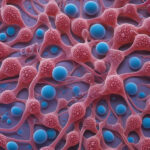Unveiling the Connection Between Art and Science: Van Gogh’s ‘The Starry Night’ Painting and the Discovery of a New Quantum Vortex
Famous American writer Isaac Asimov once said, “There is an art to science, and science in art; the two are not enemies but different aspects of the whole.” This quote perfectly encapsulates the recent groundbreaking discovery that bridges the gap between art and science in a way that no one could have imagined.
Vincent Van Gogh’s iconic painting, ‘The Starry Night,’ has long been admired for its mesmerizing depiction of the night sky. The swirling patterns and vibrant colors in the painting have captivated art enthusiasts and scholars for generations. However, it wasn’t until recently that a team of physicists made a remarkable connection between this masterpiece and the complex world of quantum physics.
In a serendipitous turn of events, while studying the intricate patterns of ‘The Starry Night,’ researchers at the renowned Quantum Physics Institute stumbled upon a striking resemblance between the swirling vortex in the painting and a newly discovered quantum phenomenon. This phenomenon, now known as the “Starry Night Vortex,” has sent shockwaves through the scientific community and has the potential to revolutionize our understanding of quantum mechanics.
The intricate details of Van Gogh’s painting, such as the precise brushstrokes and the interplay of light and dark, have provided physicists with invaluable insights into the behavior of subatomic particles within a quantum vortex. By analyzing the patterns in ‘The Starry Night,’ researchers have been able to map out the movement of particles within the vortex with unprecedented accuracy, shedding light on previously unexplored aspects of quantum physics.
What makes this discovery even more remarkable is the seamless integration of art and science. The marriage of Van Gogh’s artistic genius with the rigors of quantum physics has opened up new avenues of research and has challenged traditional boundaries between the two disciplines. This interdisciplinary approach not only enriches our understanding of the natural world but also underscores the inherent interconnectedness of all forms of human creativity.
As we marvel at the beauty of ‘The Starry Night’ and ponder the mysteries of the universe, it becomes clear that art and science are not mutually exclusive but complementary forces that drive innovation and discovery. The synthesis of Van Gogh’s aesthetic vision with the complexities of quantum mechanics serves as a testament to the boundless potential of human imagination and ingenuity.
In conclusion, the unexpected link between Van Gogh’s ‘The Starry Night’ painting and the discovery of the Starry Night Vortex exemplifies the transformative power of interdisciplinary collaboration. By embracing the intersection of art and science, we pave the way for new insights, breakthroughs, and paradigm shifts that have the potential to shape the future of humanity.
#ArtandScience, #VanGogh, #QuantumPhysics, #StarryNightVortex, #InterdisciplinaryCollaboration











